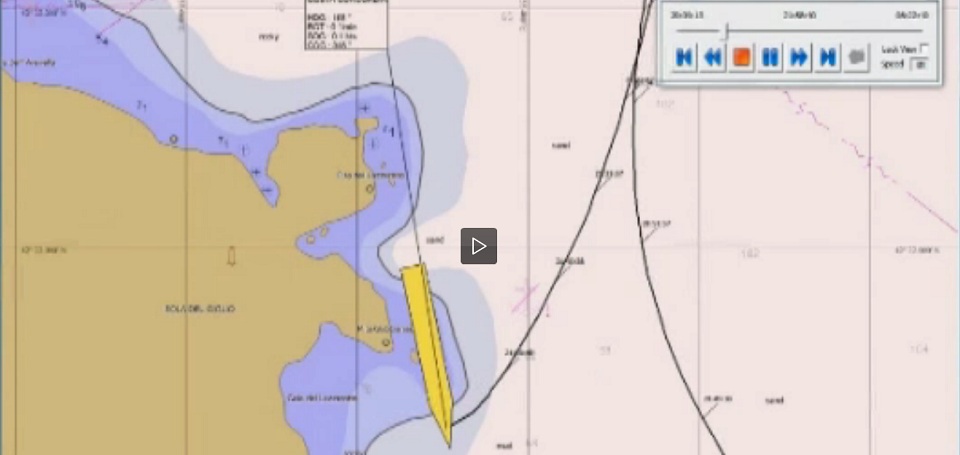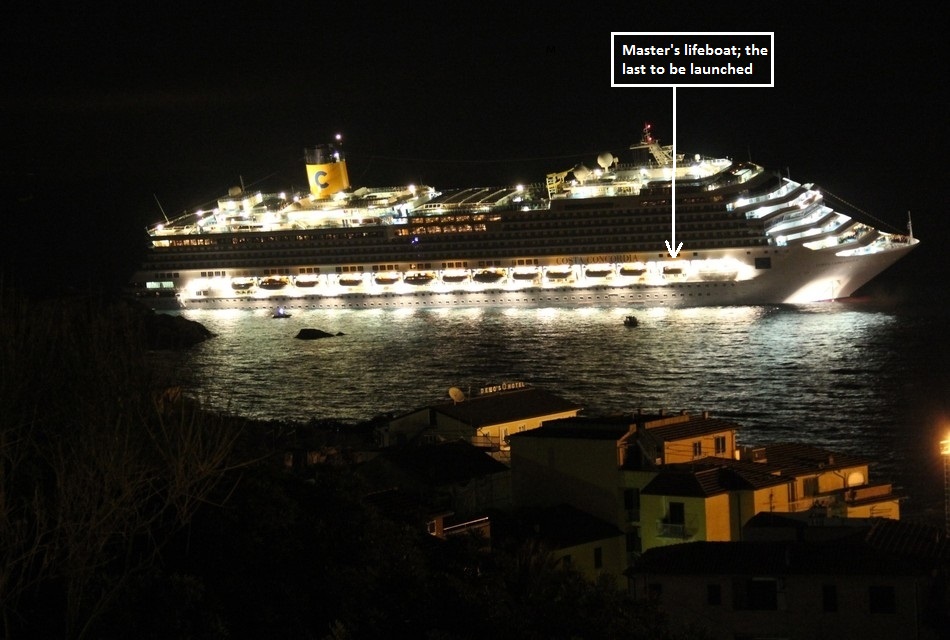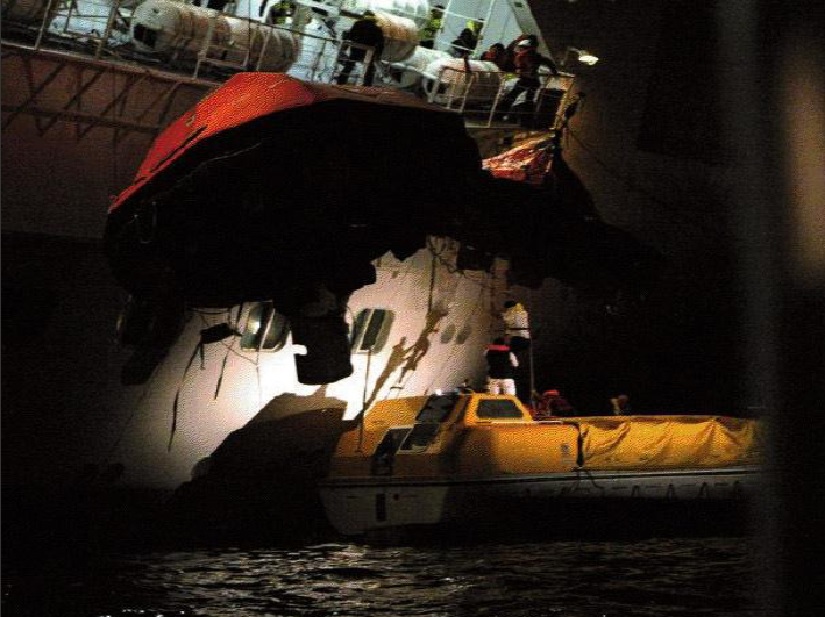|
|
|
|
After the contact and the Black-out the ship had lost propulsive power and could not be steered anywhere. Only due to pure LUCK (or an act or hand of God!) wind and current pushed the ship back towards the rocky shore of the Giglio island, where, between 22.33 and 22.44 hrs 13 January, 2012, vessel's starboard bilge touched two rocky outcrops of the sloping sea floor north of Gilgio port at ~8 meters draught forward and ~12 meters draught aft (mean draught ~10 meters) and anchors were apparently dropped (emergency light had been switched on when the Black out occurred at 21.50 hrs). The ship was not heeling at all. Had the wind and current been different, the ship would have drifted somewhere else into deeper water, where it would have capsized and sunk completely after the capsize. To suggest that the ship was aground is not correct as aground means that the flat bottom of the ship is resting on the sea floor, which was not the case. The ship was floating, drifting and pushed slowly by the wind against the rocky outcrops. It is now the vessel started to heel to starboard due to the wind force on the deck house in combination with reduced GM/GZ and bilge touching ground. The stability at this time with three compartments up-flooded was still in order (only intermediate stages earlier had been critical) - Source: www.safety4sea.com/images/media/pdf/Costa_Concordia_-_Full_Investigation_Report.pdf (p 127): "As far as the two damages to four flooded compartments are concerned, the m/v COSTA CONCORDIA, although complying with all the damage stability criteria provided by SOLAS 74 Consolidated Edition 2004, during the intermediate stages does not show satisfactory stability criteria. As a matter of fact considering the damage to the compartments 4-5-6-7 (DS04-07) the margin line results submerged by 0,111 m., the range of stability is practically null (actual 0,09° against 15°) and the diagram area under the lever curve in the range of stability results null, so that such damage is a quite critical stability situation due to the consequences of the progressive flooding (leakage of water from the damaged compartments to the intact ones [through open watertight doors]) even though the GM is satisfactory enough (GM=0,91M). Furthermore the progressive flooding of the compartments aft of no. 4 is almost reached, i.e. aft of frame no. 44." Evacuation and abandon ship was possible during almost two hours. When four watertight compartments were up flooded, <14 000 m3 buoyancy was lost, draught increased abt. 1.2 meters and ship trimmed 4.06 meters on the stern - aft draught became 11.54 meters due to the 21.45 hrs contact. The flood water did not reach the bulkhead deck and stability was in order. The ship was therefore 100% safe - but abandon ship was still necessary as you could not feed the people aboard, etc! Schettino was quite happy. The ship could be towed for repairs. Schettino didn't know that, if the ship heeled, e.g. due to wind, that the bulkhead deck may be submerged at side making the situation less safe due to down-flooding. According Wikipedia: "Without propulsive power and on emergency electric power, the ship "shifted position only by means of inertia and the rudders" and continued north from Le Scole until well past Giglio Porto. Captain Schettino has said various instruments were not functioning. Reports differ whether the ship listed to port soon after the impact and when she began listing to starboard. At 22:10, the vessel turned south. The vessel was then listing to starboard, initially by about 20°, coming to rest by 22:44 at Punta del Gabbianara in about 20 metres of water at an angle of heel of about 70°. Captain Schettino attributes the final grounding of the ship at Punta del Gabbianara to his own effort to manoeuvre the ship there. In contrast, on 3 February, the chief of the Italian Coast Guard testified that the final grounding of the ship at Punta del Gabbianara may not have been related to any attempts to manoeuvre the ship and the ship may have drifted simply due to the prevailing winds that night". Evidently the above is a typical Wikipedia falsification of events. The below path of final displacements may not be correct (a 180° turn 1 000 meters north + drifting sideways at 1 knot due NNE wind (?) but against the current!) but the ship ended up outside the Giglio harbor. There are various, unverified and strange and/or unrealistic proposals/simulations:
Source: http://www.youtube.com/watch?v=PxrEEpIs2iM (note vessel bilge touching at midship)  Source: http://video.repubblica.it/dossier/naufragio-giglio-costa-concordia/la-rotta-della-concordia-minuto-per-minuto-il-tracciato-gps/86139/84528 (note the ship is sitting on land) At 22.26 hrs Schettino advised the Livorno Maritime Rescue Sub-Centre (MRSC), that the ship was taking in water and was listing. The lifeboat alarm, i.e. General ship alarm was apparently given by Schettino (the VDR confirms the time! - 22.33 hrs - 2 hours prior capsize and 48 minutes after the accidental contact). Now LSA would be made ready for Abandon ship. At 22.48 hrs Schettino asked the MRSC for tug assistance. The Italian Coast Guards (ITCG) queries Schettino about the eventuality of an Abandon Ship with the reply being that such a possibility was being evaluated. I assume 300 of the alleged 1 000 crew members were asleep (to work next morning), so they had to be awoken. It would have been a good idea to remind all staff via the loudspeakers not to open any watertight doors during evacuation and to tell all passengers also via the loudspeakers to immediately go and collect their life vests, ID, money, keys, tickets, valuables in the cabins (only ~200 meter and 4 or 5 decks up/down) and to put on warm clothing there and then proceed to one of the two muster stations (another ~50 meter and 4 or 5 decks down) for further info and that cabin stewards visited all passenger and crew cabins to ensure nobody was sleeping and left behind ... and that all watertight doors were closed! Most (~99%) persons aboard were then evacuated using the lifeboats but very few rafts. The staff should have used the life rafts. Now they took the seats of the passengers and the lifeboats were overloaded. Probably port lifeboats were launched first. The harbor of the island was only 300 meters away.
At 22.33 hrs the General Alarm was thus raised and then all lifeboats should be made ready and lowered to the embarkation deck in 10 minutes. Around 22.50 hrs the damaged ship was clearly floating and not aground but with starboard bilge in contact with the sea floor, anchored (!), outside Giglio harbor with stern trim and starboard list as per photo below: 
M/S Costa Concordia floating and at anchor but being pushed against the shore by wind. Not one lifeboat or life raft has yet been launched of course. That is for later At 22.58 hrs on further solicitation by the MRSC, Schettino informed that the Abandon ship order had been given. After mustering was completed with all passengers and staff at the muster stations and the Abandon ship procedure started and 10 starboard and 10 port lifeboats, full with passengers and crew, were apparently lowered into the water starting around 23.04 hrs. So far so good. But six lifeboats were not made ready correctly and three of them not used at all. It has never been clarified! It seems three starboard lifeboats were not made ready in time, so several hundred passengers had to traverse across the ship to get to the port side. Only much later all starboard lifeboats were in the water. But three port lifeboats were not used at all!
Note again that the M/S Costa Concordia was at this time floating but with starboard bilge touching two rocky outcrops of the sloping sea floor and stable with a small list (<8° so you can walk on the decks) to starboard and small stern trim (6 meter). The emergency lighting illuminates life boat embarkation areas and emergency routes. It is likely that the small list was due to the wind acting on the deck house. The stability was positive but reduced and a wind force is the reason for the list. Very few life rafts were launched on the starboard side as the cranes were blocked. 
Crew failing to launch life rafts and escaping by climbing ladder to life boat Only 6 life rafts out of 69 were used at the evacuation and most of them was on the port side. A life raft is easy to launch by crane, if you know how, and it can carry 25-35 persons (staff). There were at least 30 rafts available on the starboard side and none or few seems to have been used! 500-700 persons (staff) could have been saved by the starboard life rafts. As the life rafts were not used, passengers not having found a seat in a starboard lifeboat, were apparently forced to walk upwards to the port side. Why the starboard life rafts were not used need to be clarified but is not clarified 2017. Didn't the crew know how to launch them? Were there no crew to launch them? 12 persons were found drowned close to the starboard aft life raft launch station. Later three more starboard lifeboats were launched but on port side three lifeboats were never used. Schettino has informed that he left the bridge when the heeling up to ab. 20 degrees, and the bridge was then out of power and communications. It had then been reported big problems with the launching of the lifeboats, as the launching crew experienced problems with the erecting of the telescopic davit arms. The telescopic davits had quite recently been modified in Finland, by the installation of an extra "power packet" of compressed CO2 "to push the davits out", and this system were reported to have failed for some lifeboats. Schettino was familiar with the launching system, and decided to send an officer to the port side to supervise the launching, while himself he went to the starboard side to help with the launching. He assisted by several launchings and probably saved lives by that action. By his entering to the "sinking side" of the ship, he also put his own life at risk. When the ship suddenly started to capsize, Schettino jumped on the roof of a lifeboat. On the port side, life rafts were also not used. It is a fact that most life rafts on Costa Concordia were not used to evacuate staff. I personally prefer using a life raft to get off a ship. Just hook it up to the crane, open it, jump in and release it ... and you are safe and dry in the water, where a lifeboat is supposed to connect and tow you away. (Apparently - May 2013 - Italian accident investigators found out that plenty crew was missing to launch the life rafts, i.e. the ship was not seaworthy. But ... they didn't report it! I wonder how much they were paid to to do so?). The open mooring/bulkhead deck aft was probably above water at starboard side. Maybe the time is 1 hr 40 minutes before the capsize that followed and ended about 00.34 hrs the next day? The ship trims on the stern as expected but it would appear that stern trim increases with time indicating that progressive flooding is taking place aft of an intact compartment through, e.g. a watertight door left open. The small boats in the water, one illuminating the bow and anchor chain, must belong to people from Isola del Giglio. This simulation is not correct. A little later most, 20, but not all lifeboats were launched, while the ship was still floating upright. But no starboard life rafts that could save >500 persons seem to have been launched. The list seems to be ~15° so it was still possible to walk on the decks ... to the port side: 
This picture taken around 23.30 hrs shows that, when lifeboats were arriving in Giglio port, three lifeboats on starboard side were still not lowered so that people could abandon ship. There is little action at the starboard forward and aft life raft embarcation stations/cranes due to lack of skilled crew aboard. Therefore plenty people seem to escape to the port side to try their luck there. Later Italian authorities suggested all 13 lifeboats were used on starboard side ... but is it true? No! The party or entertainment or magic show in the theater and wheelhouse aboard was over and you had to get serious. Evidently the damaged ship neither sank nor capsized due to the 21.45 hrs contact, as it was floating, albeit with three/four watertight compartments flooded but with double bottoms almost intact, with stern trim but with bulkhead deck aft above water. Nobody had died due to the contact! Schettino must have been happy. It wasn't so bad, after all! Just a small hull contact and damage/leakage/flooding ... under control! It can be repaired. The ship was safe! No real urgency to fast abandon ship. Which he reported to the office and staff at Genoa! The sea floor was only a couple of meters below the bottom of the ship at this time. If Schettino and his officers had been really alert at this critical time, you could have stopped any progressive flooding aft through an open watertight door by closing all watertight doors and pumping the intact but partly flooded adjacent compartments dry using the bilge pumps (driven by the emergency power). It seems no such action was taken to save the ship, so later, 00.34 hrs, the vessel capsized 90° towards and crashed onto the shallow water shore on starboard side and 60-70% of the ship got submerged after ship was sliding away from shore on the sea floor ... and people died! It would appear that the angle of heel was about 45° at 00.28 hrs (the ship was still floating), when Schettino had reached the shore nearby and could witness the sinking from there. Had the 21.39 hrs initial starboard turn been done correctly so you passed a little further from shore and rocks on a straight course, nothing would have happened and the €415 million ship would have continued to Savona and no passenger had known anything. OK, Savona is a very boring place. Who goes there on a cruise? OK, all people just sleep aboard then and the Germans get on/off! No shore excursions! Cruising is just for fun anyway! In January? If you make money out of it. It was a very cheap cruise for poor people.
But why didn't they use all the life rafts? Apparently the few crew members trained to launch them were lacking to launch them! Go to Part 4. Back to Introduction!
|